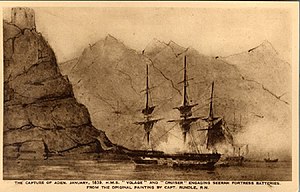| Aden Expedition | |||||||||
|---|---|---|---|---|---|---|---|---|---|
| Part of the conquest of Aden | |||||||||
 Contemporary painting showing British warships engaging Sira fortress batteries | |||||||||
| |||||||||
| Belligerents | |||||||||
|
|
| ||||||||
| Commanders and leaders | |||||||||
|
|
| ||||||||
| Strength | |||||||||
|
Land: 700 infantry[1] Sea: 1 frigate 1 corvette 1 brig 1 schooner |
700 infantry 33 artillery pieces 1 fort | ||||||||
| Casualties and losses | |||||||||
|
None 1 corvette damaged |
150 killed or wounded 139 captured 33 artillery pieces captured 1 fort captured | ||||||||
Location within Yemen | |||||||||

The Aden Expedition was a naval operation that the British Royal Navy carried out in January 1839. Following Britain's decision to acquire the Port of Aden as a coaling station for the steamers sailing the new Suez-Bombay route, the Sultan of Lahej, who owned Aden, resisted, which led to a series of skirmishes between the two sides. In response to the incidents, a small force of warships and soldiers of the East India Company were sent to Arabia. The expedition succeeded in defeating the Arab defenders, who held the fortress on Sira Island, and occupied the nearby port of Aden.[2][3]
- ^ "Seizure of Aden 1839 - FIBIwiki".
- ^ Clowes, pg. 277-279
- ^ Playfair, pg. 162-163
